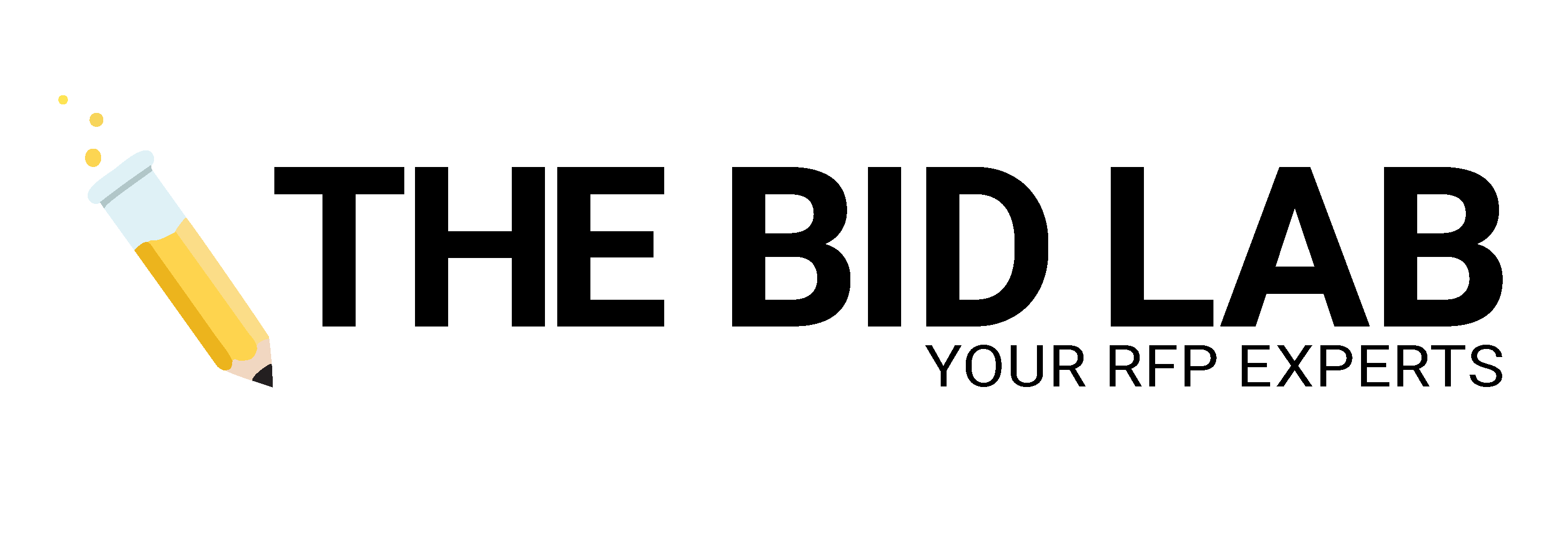RFP Layout: Tips to Design Bids Exactly Right


When your organization offers the best products or services, getting the RFP layout of your bid response right can mean the difference between a winning bid and missing out on new business. Your bid must be 100% responsive to the Request for Proposals (RFP). A clear RFP structure is key to highlighting your responsiveness without overwhelming the reader. That way, the person reviewing your proposal knows exactly where to look to evaluate your bid correctly.
But this is harder than you might imagine! Some organizations reuse past RFP templates with confusing edits, and others rely on terminology that may not be clear at first. Luckily, The Bid Lab helps clients manage their RFP responses every day, and we’re happy to share the tips you need to get your RFP structure exactly right.
Start RFP Layouts with Organized Lists
The first thing you’ll need to do is read through the entire RFP. Although, anyone who has seen an RFP will know this isn’t the easiest task. RFPs can be very dense. Take the time to check each paragraph carefully. You’ll need to list all compliance requirements and necessary attachments.

Keep a separate list of every compliance issue you encounter as you read. For example, do you need to submit the bid electronically or by mail? Many public entities calling for proposals will require various registrations, certifications, insurance, etc. By keeping track of each stipulation, you can delegate the tasks among your team and ensure that every issue is resolved well in advance of the bid’s submission deadline. Getting organized is the best way to start designing your RFP layout to accommodate all necessary documentation.
The same is true for attachments. Take note of each attachment that you must submit with your bid. And be careful! Sometimes, original RFPs don’t include all the necessary attachments. Rather, organizations might add addendums or linked documents later in the process. So, the earlier you start filling out the necessary attachments, the better prepared you’ll be. It’s up to the vendors to anticipate potential curveballs (when a notary is required, for example).
Read more about how to organize documents and forms of solicitation in our Learning Center.

Make a Comprehensive Outline (but keep responses short!)
This may seem contradictory, so allow us to explain. When you’re describing a process, product or your team’s comparative advantage, it pays to be concise. Bid reviewers can easily identify excessive language or empty descriptions. So, don’t leave anything from the RFP’s Scope of Work out of your proposal.
The best approach is to match the headings and Scope of Work/Services exactly between your proposal and the RFP document. Keep the same order as well. Even if certain elements of your response repeat, it’s better to answer every field of the RFP fully. By matching your response to the RFP formatting, you will ensure a seamless connection between what you can provide and what the RFP seeks.
The goal of a perfect RFP layout is to make it as easy as possible for your evaluator. Include each item in the proper order so an evaluator can quickly identify the area of your proposal they’re searching for. You want the evaluator to spend time learning about your strengths rather than searching your bid with frustration for the details they need. So, keep your responses concise but your RFP structure comprehensive. Here’s more about the differences between business writing and proposal writing.
Think About Your Visual Elements
Some RFPs have strict formatting prerequisites for straightforward text, page limits, etc. The majority, though, leave at least some space for visual elements. Incorporating a little creative design into your RFP layout is a great way to help your bid stand out from its competition. Incorporate thoughtful visual elements to take your RFP layout to the next level.
Just make sure any visual elements are deployed with purpose. Read more about how to make your government RFP look good in our Learning Center.

Take advantage of visually engaging charts, graphs and images (pexels.com is just one of many free stock photo resources) to help make your point with greater emphasis. This will allow you to quickly convey large amounts of information in an RFP format easily digestible by your bid’s target recipient. Evaluators also value creativity. It demonstrates solid technical competency within your organization while saving time and effort.
Another way to ensure your creative design adds to, rather than detracts from, your bid is to maintain visual consistency throughout your proposal layout. Pay special attention and ensure that colors, fonts, spacing, page breaks and other formatting choices are uniform throughout your RFP. This will increase the readability and flow of your document and satisfy people’s natural preference for recognizable patterns. Incorporate thoughtful visual elements to take your RFP layout to the next level.
Still Unsure About Your RFP Layout?
You’re on your way to crafting a winning bid with a perfect layout. But if you’re unsure about getting your proposal in the perfect format, check out other articles in our Learning Center. We have all the info you need to perfect your RFP strategy. Check out 3 Common Mistakes When Submitting an RFP Response. Ask yourself: What Is Your RFP Strategy? Then, adjust your layout accordingly with The Ultimate Guide to the RFP Process.
You Don’t Have to Go It Alone
The Bid Lab helps manage, design and win bids with all aspects of the RFP process. Interested in learning more about what we do or how we can help your organization thrive? Reach out to us today for a free consultation by calling 1-844-4BIDLAB or emailing respond@thebidlab.com.
